Greystone or Graystone may refer to:

The Slater Mill is a historic water-powered textile mill complex on the banks of the Blackstone River in Pawtucket, Rhode Island, modeled after cotton spinning mills first established in England. It is the first water-powered cotton spinning mill in America to utilize the Arkwright system of cotton spinning as developed by Richard Arkwright.
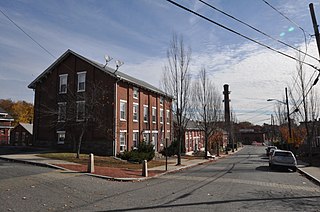
Lonsdale is a village and historic district in Lincoln and Cumberland, Providence County, Rhode Island, United States, near Rhode Island Route 146 and Route 95. The village was originally part of the town of Smithfield until Lincoln was created in the 1870s, and was originally centered on the Lincoln side of the Blackstone River. William Blaxton settled in the area in 1635. In the nineteenth and early twentieth centuries, Lonsdale was home to several manufacturers including the Lonsdale Company's Bleachery, and the Ann & Hope mill was also located in the village in Cumberland.

Allen Street Historic District is a historic district encompassing a collection of smaller textile mills in central Woonsocket, Rhode Island. The district extends on either side of Allen Street, a road isolated between Truman Drive and the Blackstone River, and includes buildings dating from c. 1860 to c. 1930. Of the five textile mill buildings in the district, four are brick structures built between about 1900 and 1920; the oldest building in the district is the c. 1860 Pond's Warp Mill at 148 Bernon Street. The latter is also adjacent to a rare visible fragment of the once-extensive canal works that characterized the industrial center of Woonsocket. Many of the district's buildings have been converted to housing.

The Ashton Historic District is a historic district in Cumberland, Rhode Island. The district consists of a mill and an adjacent mill village that was built for the workers of the mill. It lies between Mendon Road, Scott Road, Angell Road, Store Hill Road, Front Street and Middle Street. The district was added to the National Register of Historic Places on November 1, 1984.
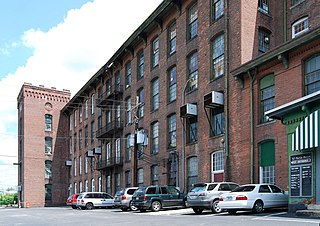
Berkeley Mill Village is a historic district encompassing the mill village of Berkeley in Cumberland, Rhode Island. The village is roughly bounded by Martin Street and Mendon Road on the north and east, railroad tracks to the west, and St. Joseph Cemetery to the south. The village, including a mill complex and mill employee housing, was built in 1872 by the Lonsdale Company. Most of the residential structures built are two-story brick duplexes, although Mendon Street is lined with a number of fine Queen Anne Victorian houses. A c. 1892 Stick-style church building, stands on Mendon Street at the northern end of the district.

The Woonsocket Company Mill Complex is a historic district encompassing one of the largest mill complexes in Woonsocket, Rhode Island. The district includes all of the buildings historically associated with the Woonsocket Company, a major manufacturer of cotton textiles in the 19th century. The complex is located along the eastern bank of the Blackstone River between Court and Bernon Streets. It includes three handsome stone mills, built between 1827 and 1859, and a power plant that was built on the site of the former #3 mill between 1890 and 1920, as well as the remnants of the canal that originally carried water to the buildings for power.
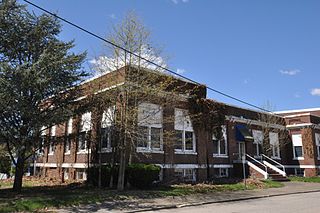
The Richmond Paper Company Mill Complex is an historic American paper mill at 310 Bourne Avenue in East Providence, Rhode Island. It consists of a collection of mainly brick buildings on 13 acres (5.3 ha) of land, bounded on the north by Bourne Avenue, the east by railroad tracks, the west by the Seekonk River, and on the south by land formerly owned by the Washburn Wire Company. The first seven of the surviving buildings were built between 1883 and 1887 by the Richmond Paper Company. The property was acquired at auction in 1894 by Eugene Phillips, who operated the American Electrical Works on the premises, adding further buildings between 1900 and 1930 and demolishing several buildings specific to paper processing. The property presently sees a variety of light industrial uses. The Richmond Paper Company is notable as the place where Arthur Dehon Little started his career.

The Dyerville Mill is an historic textile mill complex at 610 Manton Avenue in Providence, Rhode Island, USA. Its oldest buildings dating to 1835, it is one of the oldest textile mills in the city. The complex is located between Manton Avenue and the Woonasquatucket River, just south of the Dyerville Mill Pond. Remnants of the head race run south from the pond, through the property, with the tail race exiting to the southwest. The main mill building is a 3+1⁄2-story L-shaped stuccoed stone structure. The picker house is a 2+1⁄2-story stone structure southwest of the main mill, with a brick extension that also gives it an L shape and creates a courtyard with the main building. A 20th-century warehouse stands south of this complex. The mill was established by Elisha Dyer, father of Elisha Dyer and grandfather of Elisha Dyer, Jr., and was operated by the Dyer family until 1867. It was then operated by cotton broker Truman Beckwith and his son. The Joslin Manufacturing Company purchased the business in 1903 and operated textile production on the site until the 1930s. The site has thereafter seen other light industrial uses.

The Rising Sun Mill, formerly the National and Providence Worsted Mills, are a historic textile mill complex located at 166 Valley Street in Providence, Rhode Island. The complex consists of thirteen brick and stone structures, ranging in height from one to four stories, located on the banks of the Woonasquatucket River in the Olneyville neighborhood of the city. Most of them were built between 1880 and 1890, with a small number from 1907 and later. The National and Providence Company and its successors operated here from 1881 into the 1950s, a time period when Providence was a leading manufacturer of worsted wool material.

The Oriental Mills are a historic textile mill complex at 10 Admiral Street in Providence, Rhode Island. The site consists of seven buildings, constructed between about 1860 and 1917, by a variety of textile manufacturers that operated on the site. The oldest building, from c. 1860, was built by the Oriental Mills Manufacturing Company soon after its founding. It is a large three-story brick structure, presenting eight bays to Admiral Street and thirty to Whipple Street. It has a well-defined Italianate roof line with brackets. Building 3, which lies southeast of Building 1 and fronts on Oriental Street, is from the same time period and exhibits similar styling. Originally used for the manufacture of cotton textiles, the complex was purchased in 1918 by the American Silk Spinning Company, which pioneered the blending of nylon fibers into its products here.

The Wanskuck Historic District is a historic district in the city of Providence, Rhode Island encompassing a mill village with more than two hundred years of history. As early as the mid-18th century, mills stood on the West River in northern Providence, a development which continued with the rise of industrialization in the 19th century. The mill village of Wanskuck is organized around three thoroughfares: Branch Street, Veazie Street, and Woodward Road, and is roughly bounded on the east by Louisquisset Pike and to the northwest by the city line with North Providence. The West River runs through the district, with its banks lined by two late-19th-century mill complexes. The village area includes a variety of examples of mill worker housing, from duplexes to rowhouses, as well as two church complexes and a community hall built in 1884 by the Wanskuck Company.

The Crompton Mill Historic District is a historic district encompassing a mill complex at 20 Remington Street, 53 and 65 Manchester Street in West Warwick, Rhode Island. The mill complex consists of a collection of mainly brick buildings, bounded by the Pawtuxet River and Pulaski, Remington, and Manchester Streets in the village of Crompton. The mill complex formerly extended across the river, but the complex on the west bank was destroyed by fire in 1992. The oldest elements of the complex are the dam site and some of the raceways that provided water power to the mills. The present dam was built in 1908, replacing an 1882 structure. The raceways were built in 1807, around the time of the first mill buildings. The stone Mill No. 1, built 1807, is believed to be the oldest stone mill building in the state. Most of the complex's buildings were built in the late 19th and early 20th centuries by the Providence Manufacturing Company and its successors. The mill was used for textile processing until 1946, when the Crompton Corporation ended production.

The Pawtuxet Valley Dyeing Company was a historic mill complex at 9 Howard Avenue in the town of Coventry, Rhode Island. The complex included three buildings: the main mill building and two pump houses, as well as the dam which impounds the Pearce Mill Pond, and the tailrace which evacuates water from the mill into the North Branch Pawtuxet River.
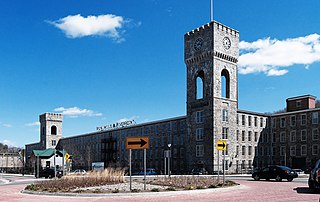
The Royal Mill Complex is an historic textile mill site at 125 Providence Street in West Warwick, Rhode Island. The mill complex was listed on the National Register of Historic Places in 2004. It has recently been completely renovated and remodeled into 250 residential apartments. The complex also includes the Ace Dye Works mill on the south side of the river, which has been converted into lofts. A pedestrian skybridge connects the two mills.

The Jules Desurmont Worsted Company Mill is a historic mill at 84 Fairmount Street in Woonsocket, Rhode Island. The mill complex consists of three brick buildings, erected 1907-10 by Jules Desurmont, the owner of a textile firm in Tourcoing, a city in northern France, who had been drawn to Woonsocket by the promotional activities of Aram Pothier. The mill produced French worsted wool yarn until 1952, and was used for many years thereafter by smaller textile and industrial concerns.

The Greystone Historic District is a historic district encompassing the early 20th-century mill village of Greystone in North Providence, Rhode Island. The district most significant elements is the Greystone Mill, a complex of brick industrial buildings on the North Providence side of the Woonasquatucket River, as well as the dam spanning the river and a water tank in Johnston. The village, entirely in North Providence, was developed between 1904 and 1912 by Joseph Benn and Company, the mill proprietors, to provide housing for its workers. The main focus of the village is on junction of Greystone Road and Oakleigh Avenue. The company built a variety of housing types, including duplexes and tenements, which line some of the side streets. There are four houses, dating as far back as 1822, that predate the primary industrial activity here. The most prominent feature of the village is the Greystone (Primitive) Methodist Church on Oakleigh Avenue.
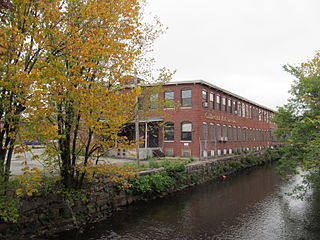
The Earnscliffe Woolen-Paragon Worsted Company Mill Complex is a historic mill at 25 and 39 Manton Avenue in Providence, Rhode Island. It consists of a grouping of eleven industrial buildings on 4.4 acres (1.8 ha) in the Olneyville neighborhood of Providence, on the banks of the Woonasquatucket River. The buildings were built between 1898 and about 1939. Building 1, the oldest building, began in 1898 as a two-story rectangular brick structure with a three-story tower and a monitor roof, but was expanded over the years, obscuring both the tower and the monitor. The complex was begun by the Earnscliff Woolen Company, which failed in 1909. The Paragon Worsted Company purchased the property, and operated on the premises until 1960, when the company closed the mill.
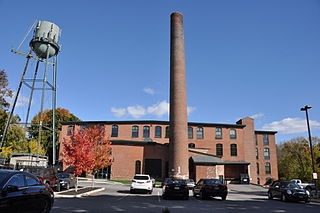
The Pocasset Worsted Company Mill is an historic industrial complex at 75 Pocasset Street in Johnston, Rhode Island. It consists of a complex of four connected brick buildings, built between 1897 and 1902. The buildings form a rough U shape on a 3.38 acres (1.37 ha) parcel of land between Pocasset Street and the Pocasset River. The two legs of the U are nearly identical main mill buildings, constructed in 1897 and 1902; they are joined by an engine and boiler house. The mill office building is attached to the southern (1897) mill building. The Pocasset Worsted Company was Johnston's largest employer in the early 20th century; its buildings were used for textile production until 1989.
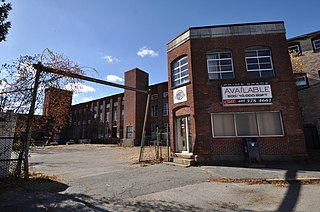
The Lymansville Company Mill is a historic industrial complex at 184 Woonasquatucket Avenue in North Providence, Rhode Island. The oldest portion of the complex, a three-story brick building which originally a textile spinning and carding building, was built in 1884. The mill was significantly expanded in subsequent years, with its last addition taking place in 1951. The Lymansville Company was founded in 1884 and closed in 1957. Auguste Albert Sack, the leading partner in the company, was a German immigrant with significant work experience in New England's textile industry.





















